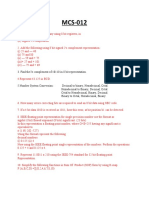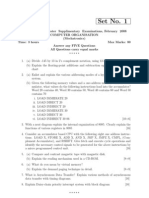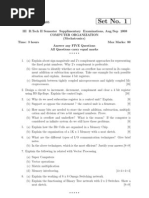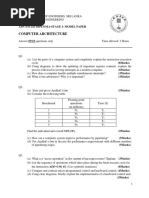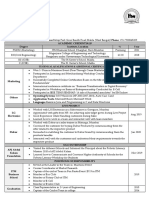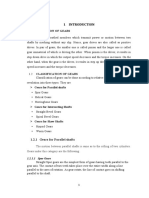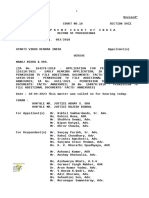NR Computer Organization
Uploaded by
sarathy1231NR Computer Organization
Uploaded by
sarathy1231Code No: 21002
NR
JAWAHARLAL NEHRU TECHNOLOGICAL UNIVERSITY HYDERABAD
MCA-I Semester Supplementary Examinations July 2010
COMPUTER ORGANIZATION
Time: 3hours Max.Marks:60
Answer any Five questions
All questions carry equal Marks
---
1.a) Using an SR flipflop design a D type flipflop.
b) Draw a combinational circuit using only NAND gates to generate the Boolean
function:
F(A,B,C,D) = A BC + B C + C D + A C D
Derive the relations used, if any, to draw the circuit.
2.a) With the help of a block diagram explain the operation of a 8 bit serial in-parallel
out shift registers. Suggest one application for such a register.
b) Construct a 5 to 32 line decoder with required number of 3 to 8 line decoders and
2 to 4 line decoders. Use block diagram approach and explain the function of the
5 to 32 line constructed by you.
3.a) What do you understand by normalization of a floating point number? Explain
with an example.
b) Write down a four bit BCD code and four bit gray code and explain their relevant
features.
4. The 8 bit registers AR, BR, CR and DR have the following initial values.
AR = 11011010
BR = 11100101
CR = 10101010
DR = 11111110
Determine the contents of each of the registers after execution of the following
sequence of micro operations.
AR ← AR – DR…………………...subtract DR from AR
BR ← CR + BR…………………...add BR to CR
CR ← CR + 1; CR← CR ^ BR…...increment CR, and the contents CR and BR.
5. Explain the Booth’s algorithm for signed two’s complement numbers with the
help of a block diagram. Give a numerical example of implementation of Booth’s
algorithm with 5 bit number.
6. Write a brief notes on the various addressing modes used in a computer with
simple examples.
7.a) The logical address space in a computer system consists of 128 segments. Each
segment can have upto 32 pages of 4k words in each. Physical memory consists
of 4k blocks of 4k words in each. Formulate the logical and physical address
formats.
b) List out the parameters required to be taken / considered for choosing a memory
device. Explain three such parameters in detail.
8.a) Explain in detail the necessity of an input output interface between a CPU and
peripheral device.
b) Write brief notes on input output processor.
******
You might also like
- Computer Architecture - CSE4001 "Operating Principles of The Computer Architecture"No ratings yetComputer Architecture - CSE4001 "Operating Principles of The Computer Architecture"60 pages
- JNTUK Computer Organization Nov 2015 Question PaperNo ratings yetJNTUK Computer Organization Nov 2015 Question Paper4 pages
- C0-R4.B4 Page 1 of 2 January, 2019 (6+6+6)No ratings yetC0-R4.B4 Page 1 of 2 January, 2019 (6+6+6)2 pages
- COA Assignment: This Assignment Consists of 10 Questions. Each Question Is of 5 MarksNo ratings yetCOA Assignment: This Assignment Consists of 10 Questions. Each Question Is of 5 Marks3 pages
- COA - Question Bank - Descriptive - New - 2021 - 22No ratings yetCOA - Question Bank - Descriptive - New - 2021 - 225 pages
- FALLSEM2019-20 CSE2001 TH VL2019201007433 Reference Material I 18-Sep-2019 DA-2 PDF0% (1)FALLSEM2019-20 CSE2001 TH VL2019201007433 Reference Material I 18-Sep-2019 DA-2 PDF2 pages
- FALLSEM2019-20 CSE2001 TH VL2019201007433 Reference Material I 18-Sep-2019 DA-2No ratings yetFALLSEM2019-20 CSE2001 TH VL2019201007433 Reference Material I 18-Sep-2019 DA-22 pages
- MCS-012 - Computer Organisation and AssemblyNo ratings yetMCS-012 - Computer Organisation and Assembly4 pages
- Computer Organization and Design (CSE-201) (Makeup)No ratings yetComputer Organization and Design (CSE-201) (Makeup)2 pages
- Term 21221: Section K20RJ CSE 211: Computer Organization and Design ONLINE Assignment No.1 General InstructionsNo ratings yetTerm 21221: Section K20RJ CSE 211: Computer Organization and Design ONLINE Assignment No.1 General Instructions4 pages
- Computer Organization and Architecture Jan 2023No ratings yetComputer Organization and Architecture Jan 20238 pages
- NR Code No: NR-12/MCA MCA-I Semester Supplementary Examinations, July/Aug 2008. Computer Organization Time: 3hours Max. Marks: 60 Answer Any FIVE Questions All Questions Carry Equal MarksNo ratings yetNR Code No: NR-12/MCA MCA-I Semester Supplementary Examinations, July/Aug 2008. Computer Organization Time: 3hours Max. Marks: 60 Answer Any FIVE Questions All Questions Carry Equal Marks3 pages
- Computer Architecture (Hot Model Papers)No ratings yetComputer Architecture (Hot Model Papers)6 pages
- CSF201 Computer Organization & ArchitectureNo ratings yetCSF201 Computer Organization & Architecture2 pages
- End Semester Examination: January, 2022 Digital Electronics and Computer OrganizationNo ratings yetEnd Semester Examination: January, 2022 Digital Electronics and Computer Organization3 pages
- Computer Organization) 01CE0402: Enroll. No.No ratings yetComputer Organization) 01CE0402: Enroll. No.4 pages
- 21CS34 SIMP Questions - 21SCHEME: Module-1 (Study Any 5 Questions)No ratings yet21CS34 SIMP Questions - 21SCHEME: Module-1 (Study Any 5 Questions)4 pages
- DLCoA Sample Questions for End Sem Exam 25No ratings yetDLCoA Sample Questions for End Sem Exam 255 pages
- C Programming for the Pc the Mac and the Arduino Microcontroller SystemFrom EverandC Programming for the Pc the Mac and the Arduino Microcontroller SystemNo ratings yet
- Ion Exchange Demineralizers: Big Problems, Small SolutionsNo ratings yetIon Exchange Demineralizers: Big Problems, Small Solutions10 pages
- Form 1 Assignment/Practice Extension Form: Module/Assessment or Placement DetailsNo ratings yetForm 1 Assignment/Practice Extension Form: Module/Assessment or Placement Details3 pages
- Buried Bodies Detection Using Ground Penetrating RADARNo ratings yetBuried Bodies Detection Using Ground Penetrating RADAR6 pages
- Femtocells Technologies and Deployment.9780470742983.51847100% (4)Femtocells Technologies and Deployment.9780470742983.51847329 pages
- Why Do Local Governments Return Money To The Treasury?No ratings yetWhy Do Local Governments Return Money To The Treasury?1 page
- Supply Chain Management: An International Journal: Article InformationNo ratings yetSupply Chain Management: An International Journal: Article Information15 pages
- Order Vyakti Vikas Kendra VS Manoj MisraNo ratings yetOrder Vyakti Vikas Kendra VS Manoj Misra3 pages
- Indian Facilities Management Services Report-Final50% (2)Indian Facilities Management Services Report-Final51 pages
- Conquilla vs. Bernardo, A.M. No. MTJ-09-1737, February 9, 2011No ratings yetConquilla vs. Bernardo, A.M. No. MTJ-09-1737, February 9, 20115 pages


















